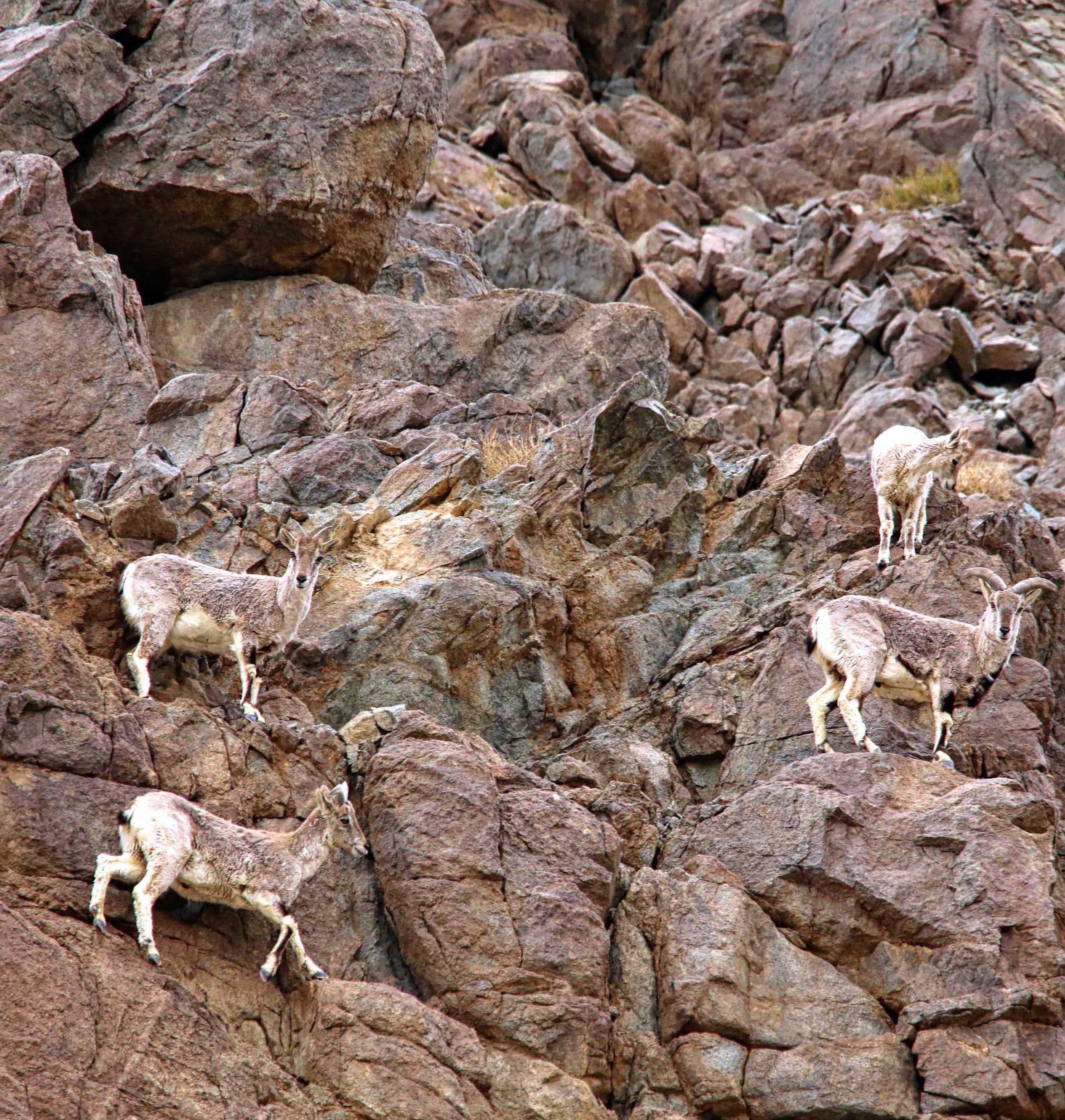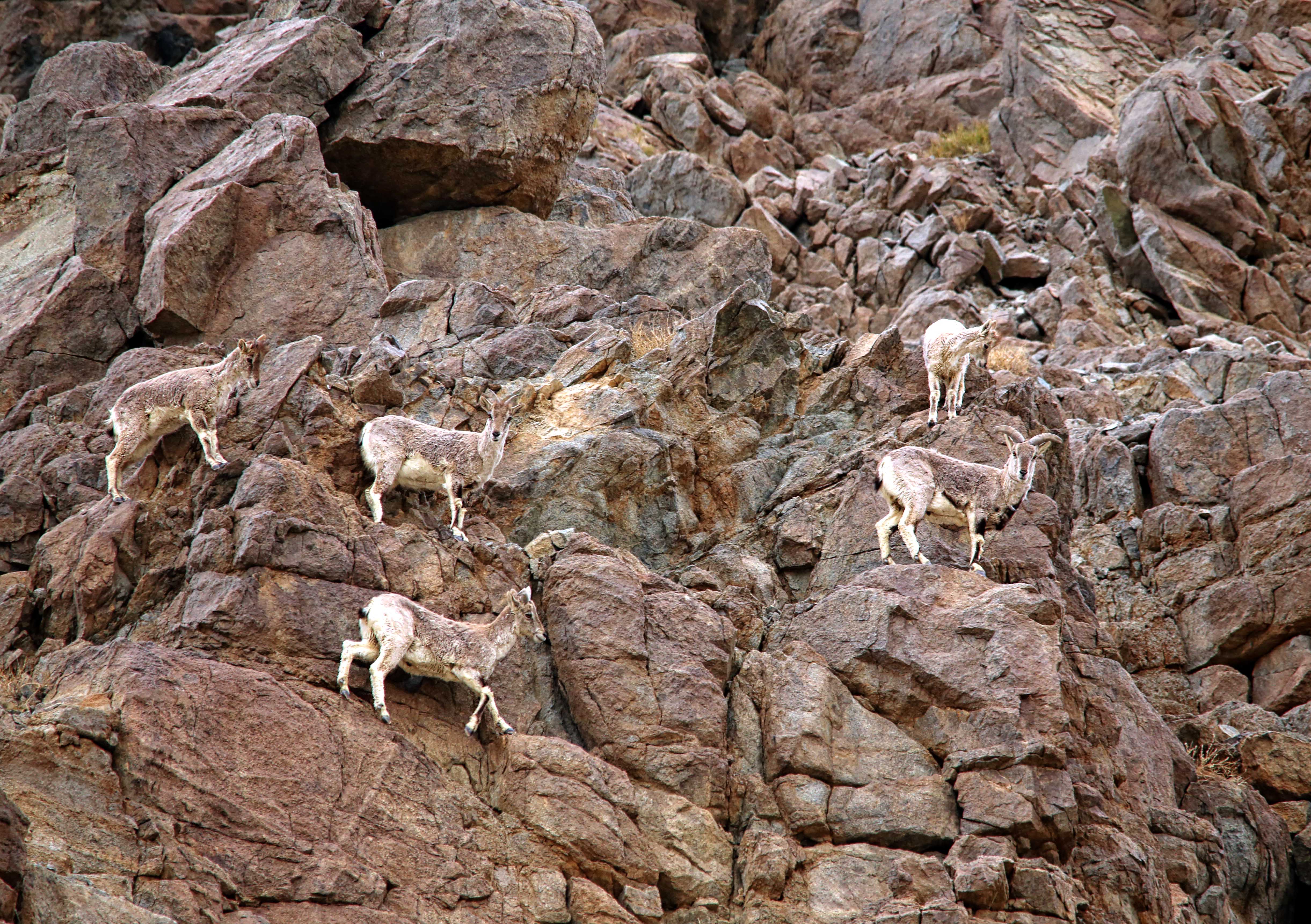Fallen rocks on the dirt road. They weren’t there when I passed the same stretch earlier. I grabbed my binoculars. It was likely that a herd of blue sheep had dislodged the rocks. In the nineties, these animals weren’t easy to find here in the pastures around Kibber Village in Spiti Valley, but fallen rocks could point me to them. About 150 m above the dirt road, I spotted a herd.
Blue sheep or bharal (Pseudois nayaur) are a species of Tibetan origin, found in the higher Himalayas and other mountains surrounding the Tibetan Plateau. They are magnificent animals, adapted to frigid ice age conditions. They stay near cliffs, and graze on relatively rolling mountain slopes. They are fast runners and worthy mountaineers, and when threatened by predators such as the snow leopard, they take refuge on cliffs.
The quest for data
There was little published research on blue sheep in the 1990s. We did not understand basic aspects of their life — their diet, what limited their populations, or how they survived harsh Himalayan winters. Each time I located a herd, a standard drill unfolded. First, count them. If a herd was larger than 15 animals, it took some effort even for an experienced observer to get this basic statistic right. Second, record the age category and sex of each animal.
The larger thickset males are easier to tell with their flamboyant horns and black chest. The nimble adult females, however, especially a young adult, can be confused with a large yearling. Telling the sex of yearlings is even more difficult. The drill involves carefully observing the horn lengths and shapes of individuals, and even leering at their private parts!

Found across the Tibetan plateau, blue sheep take refuge on steep cliffs and broken areas when they perceive a threat. Cover Photo: Surya Ramachandran
The joys of observation
Observing these animals is pure joy. A playful juvenile enticing another to a bout of dusty synchronised gambolling down a scree-filled slope. More intense interactions could be a bharal displacing a subordinate from a feeding patch with a firm nudge of a horn. Or the ritualised and intense horn clashes amongst males to test each other out as they compete for females.
At times, an alert female, detecting us at a distance, would start stamping the ground with her hooves, emitting a sneeze-like alarm call. Others would become vigilant. Occasionally, they too would start calling. The herd would eventually calm down and resume feeding, once they correctly assessed the extent of danger I posed.
You’ve been exposed
Alarm calls and warning signals are fascinating behaviours that herd-living animals employ to alert each other to possible dangers. Interestingly, solitary species such as musk deer and barking deer employ them as well. Why do they do so?
Predators have evolved to efficiently hunt their prey. But no prey wants to be eaten, and they too have evolved skills to escape predation. A large predator typically makes several attempts before it is successful in bringing down a prey. Given the efficient escape strategies of prey such as the blue sheep, predators like the snow leopard must rely on stealth and surprise. They try to approach undetected as close to an unsuspecting prey as they can, before launching into the final attack. Take the element of surprise out from this ambush and the chances of a successful hunt become negligible.
It appears that alarm calling is not just a warning to other prey animals, but it’s also a direct message to the predator — you’ve been exposed, and it will be futile to continue your pursuit. Indeed, ambush predators are known to give up hunting attempts when confronted with persistent alarm calls.
Although blue sheep use cliffs to escape predators, at times they get hunted right on the cliffs. Blue sheep may be fast runners and good mountaineers, but snow leopards too have perfected the art of ambush hunting in steep, mountainous areas.

The menu on the table
After the herd of blue sheep I was observing moved away, I would visit the exact location where they’d been feeding. From a distance, identifying the plants they ate was difficult. I therefore used to record the clues they left behind. In their feeding area, I would search for signs of foraging on plants to reconstruct their diet.
The skull, jaws, and teeth of blue sheep show adaptations to feed on grass, and not on herbs and shrubs. My study of blue sheep diet in summer confirmed that they largely ate grasses. Summer is when blue sheep — and other temperate and alpine herbivores — acquire fat-reserves that provide them a source of energy in winter. But come winter, the blue sheep diet changed. Grass consumption reduced to nearly half, and herbs and shrubs became the other half of their diet. Why should a species that has evolved to feed on grasses change its diet so drastically? It was possible that the pastures did not have enough grass in winter. Alternatively, during the harsh winter when the pastures had only dead grass blades, blue sheep could be acquiring more nutrients by feeding on herbs and shrubs.
I wasn’t able to solve this puzzle, but 10 years later, Dr Kulbhushansingh Suryawanshi, then a student, did. With difficult fieldwork over a cold winter, and some clever analyses of food plants in the lab, he found that blue sheep changed their diet because they had no choice. There simply wasn’t enough grass to graze on during winters.
Junk food
These constraints have consequences. When livestock graze the pastures and consume grasses, not enough is left for blue sheep, which are then forced to consume less preferred plants. The main consequence of this poor diet is that blue sheep have fewer offspring. Fewer females give birth each year. It became evident during the course of my work that the blue sheep population around Kibber was low because of ubiquitous grazing by a large number of livestock. No wonder it was challenging for me to find herds to collect data on.
Starvation as a way of life
Interestingly, while I found that blue sheep birth rates declined when there wasn’t enough grass, there appeared to be no detectable effect on their mortality. Another fascinating puzzle. In 2012, a study by another student, Mayank Kohli, found that as winter progresses, blue sheep start resting more and reducing the time and energy they spend searching for food. Himalayan winters are tough, and the energetic costs of keeping warm and finding food are high.
Mayank’s finding that the blue sheep seem to get through the harsh winter by eating less, rather than more, helped me eventually connect the dots. It seems that to survive the cold winters, blue sheep may have evolved a high starvation threshold, which also helps them withstand the challenges posed by the depletion of grasses.
A population eruption and its cascading effects
In 1998, based on my friendship and discussions with them, the village council of Kibber agreed to set aside some pastures for blue sheep, and to stop grazing livestock there. The results were spectacular, and the population of blue sheep increased by four times.
It wasn’t just the blue sheep that responded to the protection of their habitat. Presumably attracted by the blue sheep, snow leopards started using the area intensively. Once a place where sighting of blue sheep was difficult and snow leopards impossible, Kibber has become a destination for snow leopard tourism, thanks to the eruption of blue sheep.
A haven in China
While blue sheep populations face challenges of not having enough food because of livestock grazing, there are exceptions. My Chinese colleague Dr Lingyun Xiao worked in a fascinating part of the Tibet-Qinghai Plateau. With few livestock and highly productive pastures, blue sheep densities in parts of her study area are up to 20 times more than other regions, and nearly five times greater than in Kibber.
The blue sheep that isn’t
Like their ecology, the taxonomic and evolutionary status of blue sheep is fascinating, if somewhat confusing. The animal is neither blue, nor a sheep, though it resembles one. The first part of its scientific name, Pseudois, appears to be derived from pseudos (meaning false) and ovis (sheep). The species is actually more closely related to goats.
In the southeastern Tibetan Plateau there is a small population of what are called dwarf blue sheep (Pseudois schaeferi). Though these animals resemble the blue sheep of Kibber, they are half the size. Genetic analyses suggest that dwarf blue sheep be considered a separate subspecies, although some naturalists believe them to be a separate species.
In danger
Dwarf blue sheep are endangered. Their population is thought to be threatened by hunting, habitat degradation, and livestock grazing. These are causes for concern, considering that their entire population probably numbers just a few hundred, and considering how these threats affect their larger cousins.
Blue sheep are hunted in many parts of their range. They face food competition from livestock. Close proximity to livestock also implies the threat of disease. In Pakistan, at the turn of this century, hundreds of blue sheep died of sarcoptic mange, most likely transmitted from livestock. In China, a potentially fatal viral disease called peste des petits ruminants, that affects domestic goat and sheep, has been detected in blue sheep. In India, several blue sheep in Uttarakhand and a few in Himachal Pradesh have recently been observed with a debilitating eye infection, possibly viral keratoconjunctivitis.
Protection from hunting, improved healthcare of livestock, and collaboratively freeing some pastures from livestock grazing can ensure the long-term coexistence of blue sheep with humans and their livestock, and also improve the conservation status of snow leopards.




